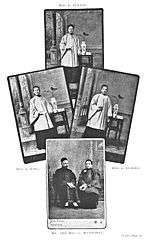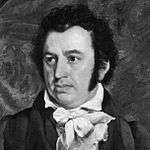China Martyrs of 1900

The "China Martyrs of 1900" is a term used by some Protestant Christians to refer to American and European missionaries and converts who were killed during the Boxer Rebellion, when attacks targeting Christians and foreigners took place in northern China.
Events
At least 189 Protestant missionaries and 500 native Chinese Protestant Christians were murdered in 1900 alone.[1] Though some missionaries considered themselves non-denominationally Protestant,[2] among those killed were Baptists, Evangelical,[3] Anglicans, Lutherans,[4] Methodists,[5] Presbyterians[6] and Plymouth Brethren.
The murder of eleven Anglican missionaries and their children on August 1, 1895 in Huashan, Fujian Province foreshadowed the devastation.[7] Foreigners, their religion, and spiritual disruptions associated with new railroad and telegraph lines were all blamed for the unusually severe flooding of the Yellow River annually since 1896, as well as the Yangtze River's flooding in 1898, and drought across north China in the spring of 1900—all of which led to famine and ultimately violence. Chinese also vehemently objected to foreign political interference (having lost the First Sino-Japanese War in 1895), the opium trade, and economic manipulations against Chinese interests.
The China Inland Mission, which lost 58 adult missionaries and 21 children in 1900, had the highest losses of any missionary agency that year. Several died in the Taiyuan Massacre; Catholic and Baptist missionaries were also decapitated in the Shanxi Province's capitol on July 9 and 11 after travelling there under the governor's orders and nominal guarantees of protection. In 1901, when the allied nations demanded compensation from the Chinese government, Hudson Taylor, a British Protestant Christian missionary to China and founder of the China Inland Mission (CIM) (later Overseas Missionary Fellowship, now OMF International), refused to accept payment for loss of property or life in order to demonstrate the meekness of Christ to the Chinese.[8] The funds instead went to found the Shansi Imperial University, whose first chancellor was the Baptist missionary Timothy Richard. other reparations founded Tsinghua University in Beijing.
The Christian and Missionary Alliance lost 36 people in its North China missions in 1900, including 21 missionaries, 12 children and three Chinese Christian assistants.[9]
The British legation in Beijing protected many Methodists, who had just concluded their North China Missionary Conference in that city on June 20, 1900 when an Imperial edict was issued authorizing the slaughter of "all foreigners in the Empire."[10]
The decapitation of missionary and Yale graduate Horace Tracy Pitkin while defending two women missionaries[11] led to the founding of the Yale China Mission, the papers of which remain a significant research source concerning early 20th century Chinese history.[12] Another large collection of missionary papers is in London.[13]
See also
References
- ↑ Culbertson, Howard (2011). "Christian mission history: Important events, locations, people and movements in World Evangelism". Southern Nazarene University. Retrieved 2013-12-25.
Ecumenical Missionary Conference in Carnegie Hall, New York (162 mission boards represented); 189 missionaries and their children killed in Boxer Rebellion in China
- ↑ "List of Protestant missionaries killed during the Boxer Rebellion" (PDF) (PDF). Thompson Brothers Geneology [sic]. Retrieved 2013-12-25.
- ↑ "The Boxer Rebellion, 1899-1901". Retrieved 2015-07-22.
- ↑ "Boxer Campaign - Battle of Feng Go Forest - Part 12 of 12". February 16, 2011. Retrieved 2013-12-25.
- ↑ D. L. Hartman. "History of Missions in China". Retrieved 2013-12-25. citing Walter N. Lacy, A Hundred Years of China Methodism, Nashville, Abingdon-Cokesbury Press, 1964.
- ↑ "American Presbyterian Missionaries Killed During 1900 in the Boxer Rebellion". Presbyterian Heritage Center. 2007. Retrieved 2013-12-25.
- ↑ Ian Welch. "Women's Work for Women: Women Missionaries in 19th Century China" (PDF). Australian National University. Retrieved 2013-12-25.
- ↑ Broomhall, Marshall (1901). Martyred Missionaries of the China Inland Mission with a record of the Perils and Sufferings of Some Who Escaped. London: Morgan and Scott. Retrieved 2006-06-21.
- ↑ "The Boxer Rebellion, 1899-1901". The Christian and Missionary Alliance. Retrieved 2013-12-25.
- ↑ D. L. Hartman. "History of Missions in China". Retrieved 2013-12-25. citing Lacy at p. 121.
- ↑ Scherer, James. "Horace Tracy Pitkin". Biographical Dictionary of Chinese Christianity. Retrieved 2012-12-25.
- ↑ "Papers of Missionaries to China". Yale University Divinity School Library Special Collections. Retrieved 2013-12-25.
- ↑ "Missionary Collections". SOAS University of London. Retrieved 2013-12-25.
Further reading
- Bryson, Mary (1904). Cross and Crown: The Story of the Chinese Martyrs. London: London Missionary Society.
- Forsyth, Robert Coventry (1904). The China Martyrs of 1900. New York, Chicago: Fleming H. Revell.
- Glover, Archibald (1904). A Thousand Miles of Miracle. Glasgow: Pickering & Inglis.
- Headland, Isaac Taylor (1902). Chinese Heroes; Being a Record of Persecutions Endured by Native Christians in the Boxer Uprising. New York: Eaton & Mains.
- Miner, Luella (1903). China's Book of Martyrs. Philadelphia: The Westminster Press.
- Historical Bibliography of the China Inland Mission
External links
- (Biographical Dictionary of Chinese Christianity online)
- OMF International (formerly China Inland Mission and Overseas Missionary Fellowship)
